Read more related stories

If things were different, we’d be spending this time preparing for Art Fair Philippines’ ninth year of giving art enthusiasts a platform to discover rising artists and masters alike by bringing together local and international galleries at The Link in Makati City.
Since we can’t exactly have an art fair right now, we figured we’d find alternatives to honor National Arts Month instead:
Cartellino Art Haul
Feb. 8 to 15
This week, Cartellino is holding its Art Haul: an online platform that allows people to experience the thrill of discovering art from various price points. In partnership with non-profit foundation Fundacion Sansó, the event gathers 200 works from over 80 local artists—all of which can be viewed at Art Haul’s website.
The lineup includes artworks from ceramic artist Aly Kangleon, sculptor Krista Nogueras, painter Art Lozano and cartoonist Manix Abrera. Art Haul’s selection of works also includes ink, pencil and oil on paper artworks, mixed-media art, handmade prints and other printed materials.
Art in the Park Online
Feb. 21 to 28
In honor of its 15th anniversary, Art in the Park will be showcasing over 6,000 artworks from 60 exhibitors and hundreds of local artists. Prices are capped at P50,000, with proceeds going to the Museum Foundation of the Philippines and its projects with the National Museum of the Philippines.
The online art fair will also be holding several events, including special tutorials from comic artist and architect Jomike Tejido, special videos on Henrielle Pagkaliwangan’s and Yvonne Quisumbing’s art-making process, as well as mini-documentaries on pottery pioneers Jon and Tessy Pettyjohn, and Joey de Castro.
Tempest, Futur:st
Feb. 5 to 18
What have your dreams looked like during the pandemic? For illustrator and graphic designer Jer Dee, they look a lot like images and experiences connected to his hometown. What started as his way of documenting his dreams has turned into his first solo show with Futur:st titled “Tempest.”
Dee’s works are available for viewing at Futur:st, and appointments can be scheduled by direct messaging their Instagram. Framed prints, stickers and postcards of his art can also be purchased through the Futur:st website.
Circles in My Mind, Galleria Duemila
Feb. 6 to Mar. 31
Created as part of the Singapore Tyler Print Institute (STPI)’s Visiting Artists Programme, Circles in My Mind is an exhibit that showcases Pacita Abad’s mixed-media assemblages, mono prints and print abstractions developed over the course of three months in 2003. The exhibit showcases how Abad incorporates lithography, screen printing and relief painting to produce paper pulp pieces.
Before Galleria Duemila, Abad’s exhibit graced the walls of California’s Andrew Shire Gallery and the Cultural Center of the Philippines. To schedule a visit, contact Galleria Duemila through Facebook or Instagram.
Attachment | Distance, Artinformal Makati
Feb. 13 to Mar. 6
After almost a year of social distancing and missing close communication with our loved ones, how have our ideas of attachment changed? Visual artist Atsuko Yamagata hopes to answer the question through her latest exhibit with Artinformal Makati, which explores how we define and control our affection amid a pandemic.
“Attachment | Distance,” is available for viewing at Artinformal Makati’s Gallery 1. Walk-in visitors are welcome.
Fired Earth, Unearthed, Modeka Art
Jan. 30 to Feb. 20
Curated by Stephanie Frondoso, “Fired Earth, Unearthed” explores the use of clay as a medium for ancient practices and current interest in ceramics due to growing appreciation for homemade and handcrafted materials—an appreciation that stems from “enlightened slow living.”
The show features ceramic works from Rita B. Gudiño, Alan Cabalfin and Hadrian Mendoza, and is available for private viewing by contacting Modeka Art through Instagram or by emailing [email protected].
We Art Online
Feb. 12 to 14
As a way of celebrating the growth of upcoming local artists, Puesto Manila is presenting We Art Online: a series of exhibitions featuring artists in various stages of their careers. The event has two galleries, one of which is the main exhibition that displays and sells artworks from established and emerging artists alike.
There’s also the spotlight gallery, which features works from eight young artists who are making waves in multiple industries. For art enthusiasts who want to take home commissioned work, “We Art Online: Bespoke” features seven artists who have mastered different persuasions and styles.
Earphones, headphones, and now, airpods or whatever you call them, are genius; you get to tune in to a song, a podcast or a video all while leaving people unbothered. For times that tend to get loud, they allow us to shut out the noise and be in our own little worlds, something that has easily become a necessity.
But what comes with tuning into something is also a tuning out from the world, which inevitably includes the people around us. Flashbacks of struggling to catch the attention of a person blasting a song in their ear may come to mind. With this, it’s time we learn to put some boundaries whenever we use them, here’s a helpful guide on how we can use these earbuds more ethically.
Adjust the volume
Literally and in line with various studies proving the harmful effects of listening to music in high volumes, we should, first of all, be ethical to ourselves by using our earphones at a reasonable volume and duration. To address this, Ear, nose and throat doctor (EENT) Dr. Sreekant Cherukuri, from northwest Indiana (who has been encountering patients with hearing problems earlier than ever) recomends a 60/60 rule. Cherukuri tells us to avoid going over a 60 percent volume and to limit usage only for a maximum of 60 minutes.
Moreover, I think what’s equally important though in a much more figurative sense, is that we adjust this piece of technology’s settings where we can still hear the voices in our heads. This ultimately helps us stay mindful of whatever we’re listening to—it’s lyrics, implications and whatnot—as well as our surroundings for the very reason that our own thoughts aren’t being drowned out by it.
Only get lost in it during your pastime

As I’ve echoed, having moments when we could zone out is crucial and is more often than not, aided by listening to something on our own. However, this should be in a setting where we could completely let loose and do so. That is, during idle times or when we plainly do not have to pay attention to anything or anyone.
I personally only let myself get lost in music either when I’m doing chores, going for a jog or stalking an ex. See? Mindless occasions. Nevertheless, the music’s there to elevate the experience by bringing rhythm to monotony.
Avoid plugging in during social gatherings

Whenever you’re hanging out with people you know, avoid plugging in and closing yourself off. It’s rude to be in their presence, only for you to implicitly shut yourself out. It’s also sad to see people discouraged to talk to you because they know that you are in fact preoccupied. Let’s not let potentially meaningful interactions pass us by like this.
Switch to speakers instead

Instead, and only if you know they won’t mind, you might want to switch to playing whatever it is you want to listen to on speakers. By doing this, you are sharing not only your music but also the experience. At best, you might find yourself liking the same things, discussing your preferences and, overall, just jamming together. But, again, only if they won’t mind, otherwise it’s just as bad as encroaching on their personal space.
Use it only for long commutes or travel

I know that traveling and being in a vehicle are usually the best times to zone out, look out the window, and pretend like we’re in a music video. But I have two points to this: First, it’s not enjoyable to cram a whole listening experience in ten minutes or so when half of the time, you know you won’t be able to listen to a substantial part of your playlist. And two, if you do decide to keep it on while you’re on the go, it can put you at risk of being in an accident.
This being said, I actually know someone whose airpods fell out of the vehicle she was in while she was traveling home and she almost got run over trying to get it back. So, consider yourself warned.
Turn the volume down at a half or only keep one earbud on

May it be listening to classical music or jazz, listening to music is known to help people be more productive. This is why it’s widely used even in the workplace. But again, this closes us off to people and in this situation, our workmates. Consequently, this makes us less attentive when they need help and can even come off as unprofessional.
So in situations like this where you have to be on your earphones, it probably wouldn’t hurt to turn the volume down to a half or only keep one earbud on.This way, you can listen to music but at the same time, still be available whenever they need you.
In the end, etiquette is all about finding compromise in our actions and its effect on other people so we might just want to reconsider our constant use of our earbuds.
Get more stories like this by subscribing to our weekly newsletter here.
Read more:
Artists Martha Atienza and Yee I-Lann on the universal struggle of island communities
The secret to truly enjoying a music fest? Mindfulness
This artist from Baguio uses paper art to make a stand about climate change
“ET home phone.”
Before you correct me on this, it was actually these exact words (in that order) that the extraterrestrial protagonist of the 1982 Steven Spielberg film said after. That was before it learned Earth syntax and properly said it the second time around—thanks to the genius that was seven-year-old Drew Barrymore.
But what did it do before the clueless children figured out what it wanted to say about the telephone? It dressed up—or at least Drew Barrymore dressed it up, in a floral dress and maximalist accessories: a bowler hat with a flower on the brim, velvet scarves, a pearl necklace, and a wavy blonde wig to pull it all together.
Despite not knowing what these articles of dressing amounted to (or if it amounted to anything at all!), it is fair to say that it made ET’s stay on earth worthwhile. And that even if it had nothing to do with what they (presumably) have back home, it’s a source of comfort (but don’t get me wrong, we’re all for self-determination here).
I’m not going to go at length about the Barthesian systems of fashion and meaning, nor will I argue for the existence of the extraterrestrial here, simply that Sydney-based designer and visual artist Paulina Paige, is sort of like the ET.
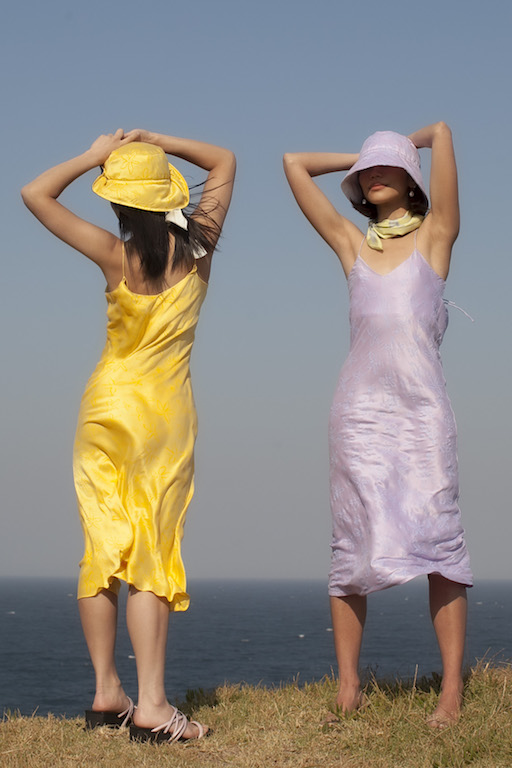
Separated from home, in her case, from the Philippines, Paulina resorted not to flying a bicycle but to creation to reconnect. Much like the lovable creature that was ET, Paulina busied herself with making “pretty things” that reminded her of home: wearable art.
This is not the first time, though. Last year, she collaborated with clothing brand Uniqlo to come up with a collection of minimalist t-shirts that evoke the sunny tropical beaches of the country. And in July that same year, she released a line called “Things You Call Home” of limited-edition silk scarves hand-dyed and hand-painted with motifs like mangoes, sampaguita, and palm trees.
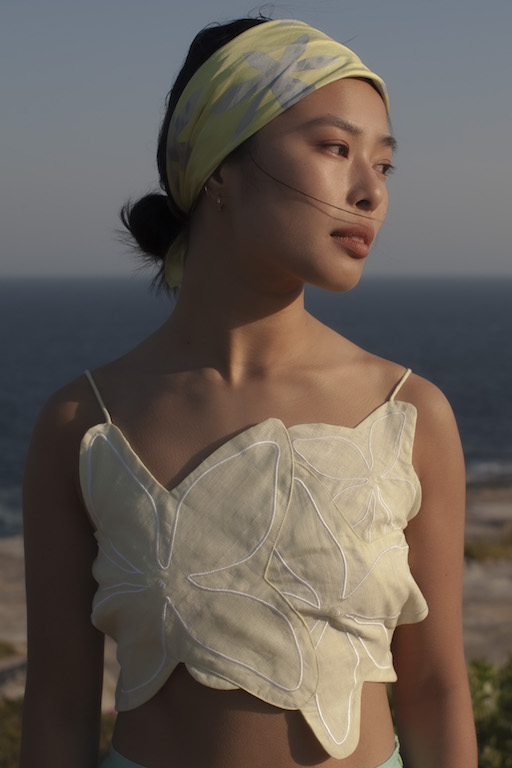
A natural instinct would be to take off from the success of these mementos of home, but Paulina does the converse. For the “Things You Call Home” sequel, the design transcends motifs as bare decor and surface-level evocations. In its lieu are collages of “foreign imagery that still felt like home.”
She’s also partnered with a few friends for two other collections of jewelry and clothing.
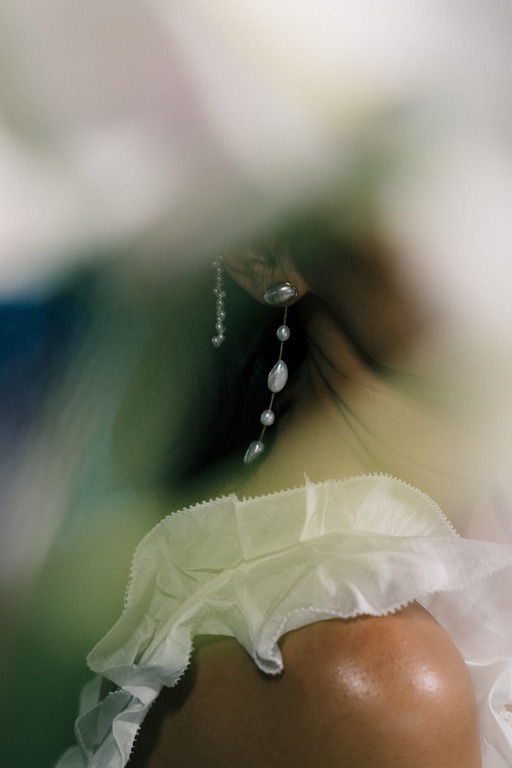
Collaborating with homegrown jewelry brand Namì, Paulina created a fine jewelry line translating sampaguitas and santan friendship bracelets to pieces made out of gold, diamond, and pearl. While with long-time collaborator and friend Carla Sison of Áraw, she designed silk slip dresses, a piña embroidered cut-out top, and bucket hats, all printed with sampaguita drawings.
We caught up with her about these collections, her creative process of evoking a sense of belonging 6,000 km away from the homeland, and being the balikbayan who bears the gifts.
First of all, congrats on the new collections. Emphasis on the ‘s.’ That’s three collections in total, two are in collaboration with Nami and Araw. Can you talk briefly about each collection? We know that the first one is a follow-up on a previous silk scarves capsule you’ve done before, but the two others—jewelry and clothes—are entire new lines, right? What are your inspirations for each one?
Thank you! Emphasis on the ‘s’ indeed.
Really, all of this started with the scarves. This is the second collection of silk scarves I’m releasing as part of an ongoing exploratory exercise, if you will. The collection is called “The Things You Call Home” because through it, I try to work with imagery and motifs that call to mind the Philippines. The first collection I released last year featured a smaller set of hand-painted scarves that lifted directly from Filpino imagery (local flora, our beaches, Philippine mangoes). But for this second set, I wanted to progress the idea of ‘home’ a little and take a new visual approach to reflect the conceptual development.
For this second volume, I lean into my collage practice and make use of drawings and imagery found in a foreign place (Mexico), that reminded me so much of the Philippines. Sort of exploring what it means to find a sense of home while being away.
The collaborations with Araw and Nami came as an extension of the scarves. They grew from the same desire to see how Philippine motifs could be integrated into beautiful objects and clothing we could wear every day, in a contemporary context.
If anything, I think it almost took me moving outside of the Philippines to really reflect upon my heritage and culture in a deeper and more nuanced way.
You seem to gravitate a lot towards sampaguita? Even at your wedding, right? Didn’t Gabbie Sarenas make you a veil embroidered with these flowers? What about these white dainty flowers attracted you?
I never thought of this in the context of my wedding. Funny you should say that.
For the Araw and Nami collections, I wanted to jump off of one of the scarves I did for my first ever set last year, which featured local flora. I suppose I wanted to work with something so commonplace in clothing and jewelry (floral prints/floral motifs) and turn that into something we could identify with more as Filipinos. Sampaguita and santan are ubiquitous in the Philippines, not just in gardens at home, or in flower garlands sold by churches, but also in the friendship bracelets many of us made as kids. These flowers are very much a part of our cultural milieu so I thought, ‘why not use them?’
View this post on InstagramCould really only do the briding thing for a few seconds 💁♀️ 📷 @otherjoseph
It’s sort of a homecoming for you, don’t you think? Although, we know, of course, that you go back quite frequently. You’re like that balikbayan kin who comes back for Christmas bearing gifts for everyone. Do you always come home to the Philippines this time of the year? What do you look forward to most during the holidays?
This is so funny. I love this analogy.
I don’t always, but I do so more than I don’t. I most look forward to the company of family and friends, as well as stuffing my face with all the food. Christmas in the Philippines is unparalleled elsewhere in the world.
You’re based in Australia and yet you manage to get inspirations rooted in the Philippines and successfully evoke and translate them into tangible objects. How do you stay connected to local culture while living in an entirely different land?
If anything, I think it almost took me moving outside of the Philippines to really reflect upon my heritage and culture in a deeper and more nuanced way. Almost like I had to more intricately examine who I was and where I came from once I was situated in completely foreign environments. It’s forever an ongoing process and learning experience, but I’m happy I’ve been able to channel the reflection into creative pursuits (and also align them with my proclivity for pretty things).
In connection to this establishing a connection to your Filipino roots through your creative outputs, what’s a dream project that you hope to execute or realize soon?
I think at some point I’d love to bring all of the pieces to Sydney (which is home for me now, too). Share a slice of that Filipino culture with this side of the world.
Get more stories like this by subscribing to our weekly newsletter here.
Read more:
This Filipina designed Uniqlo’s new line of minimalist T-shirts
This is modern Filipiniana you can wear with jeans
Personalize your jewelry with these 5 local brands
A few weeks ago, Salcedo Auctions’ subsidiary Gavel & Block held a live auction event on items made by art icons like Henri Matisse, Salvador Dali, Arturo Luz, and Vincent Manansala.
But unlike that of 2017 when they had a sale on rare and antique items, the upcoming auction will exhibit works of Filipino masters highlighting Felix Resurreccion Hidalgo’s painting “La Pintura,” as well as others by Juan Luna, BenCab, and Jose Joya.
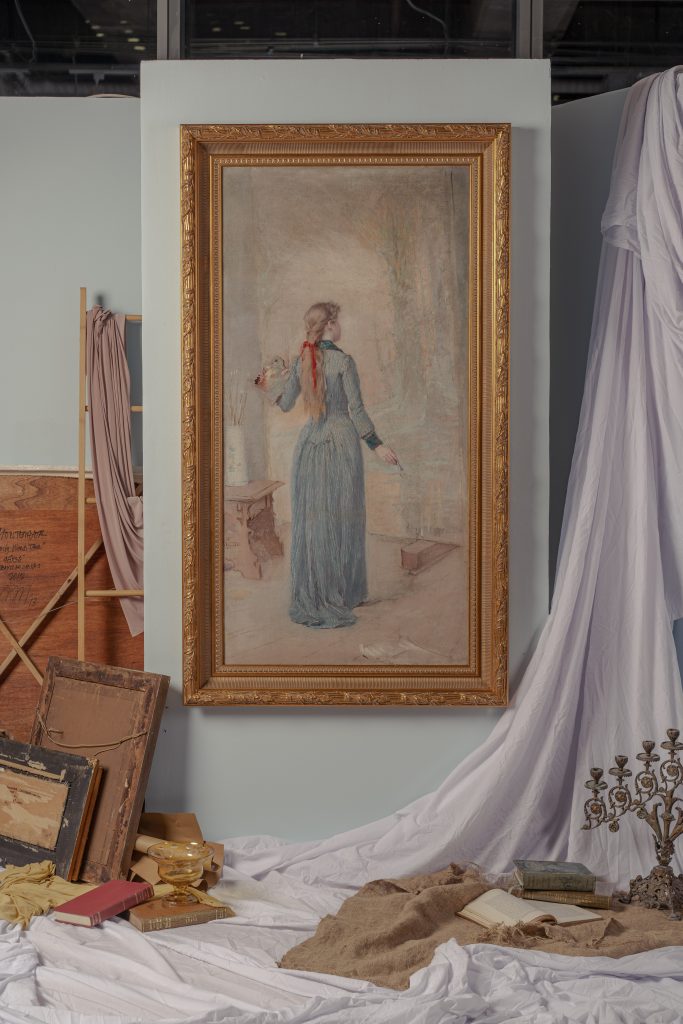
Hidalgo landed a silver medal at the National Exposition of Fine Arts in Marid through the “La Pintura” where he depicted a woman standing in front of an unfinished canvas; a serendipitous moment where the viewer contemplates the art as the woman in the art contemplates her work.
Entitled “The Well Appointed Life,” the auction will also preview furniture, rare timepieces, and jewelry which bidders may choose from.
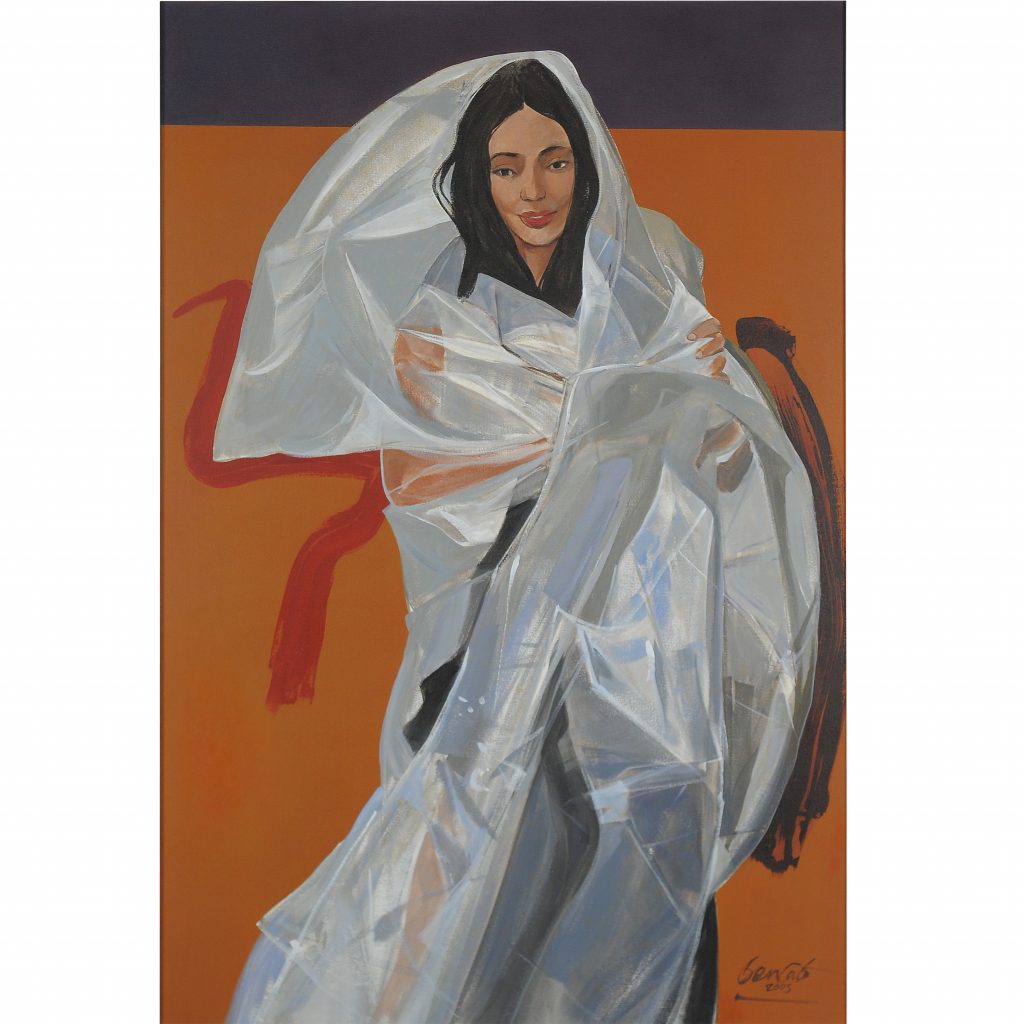
Established in 2010, this auction house specializes in selling fine art, jewelry, decorative arts, and collectible accessories by leading artists and artisans in the local and international scene.
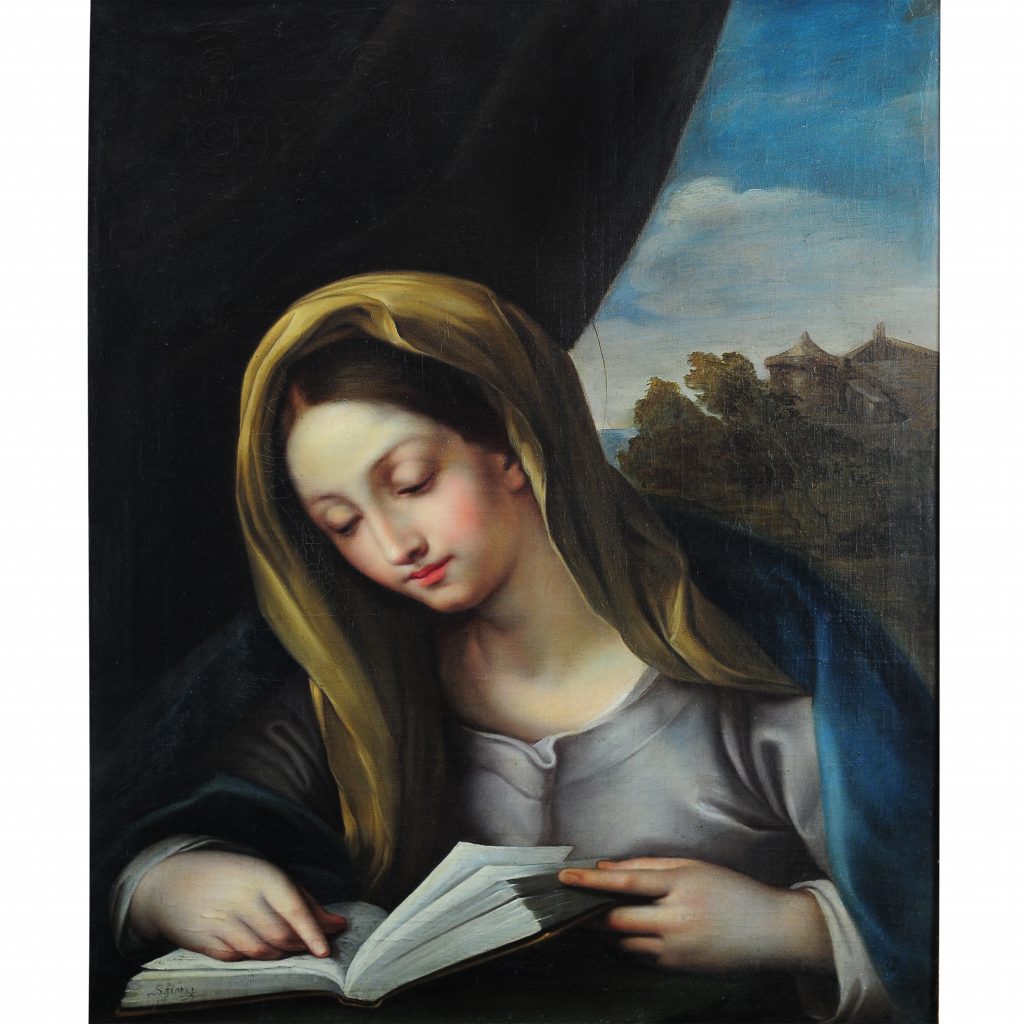
The preview for the auction event will happen on Sept. 13 until Sept. 20 at the Peninsula Manila.
Update
Last Saturday, Sept. 21, Hidalgo’s painting “La Pintura” was sold with the highest world record of P78 million (VAT and buyer’s premium included). The former world record was achieved at an auction in Madrid, Spain on October 2018 for an oil canvas entitled “Pareja de jóvenes tagalos ante un rio” which was sold at the price of P51 million.
This is also said to be the highest amount ever paid for a work by Hidalgo.
Header photo courtesy of Salcedo Auctions.
Get more stories like this by subscribing to our weekly newsletter here
Read more:
How to bid at auctions and start your own collection
Salcedo Auctions has another Juan Luna boceto on the block
Manila wet market caught selling shark meat despite law
Prominent painters Juan Luna, Felix R. Hidalgo, Fernando Amorsolo, Guillermo Tolentino, Carlos “Botong” Francisco, Emilio Alvero, and Tomas Mapua may have different approaches in art, but they all honed their skills at the same place: the Escuela de Bellas Artes.
Known as one of the first fine arts academies in the Philippines, the arts school was located in a Quiapo mansion owned by artist Rafael Enriquez y Villanueva. After letting young artists gather in the mezzanine of his house in the 1870s, Enriquez decided to officially transform it to a school called Escuela de Bellas Artes.
https://www.facebook.com/PilipinasRetrostalgia/photos/a.1646500778931146/1669307096650514/?type=1&theater
Sadly, the school was moved to the Padre Faura campus of the University of the Philippines which left the Quiapo edifice in “a state of decline.” An Inquirer Lifestyle article reported that after Enriquez’ death, the house became “a dormitory, bowling center, restaurant, venue for live sex shows, even an abortion clinic before the homeless took over the house, as they did other stately homes in the area.”
It wasn’t until 2006 when the historical building was honored, following Jose “Jerry” Acuzar’s decision to acquire the structure and restore it in the now famous Las Casas Filipinas de Acuzar.
(READ: Contemporary art finds a home in heritage park Las Casas de Filipinas de Acuzar)
Now that the building in Bataan has been rebuilt, non-profit organization Bellas Artes Projects decided to open in their Makati outpost a school like Escuela de Bellas Artes—a place where anyone interested in the arts can gather. Only this time, it’s focused on a more interdisciplinary and contemporary approach.
“Eskwela”
Named “Eskwela,” Bellas Artes Projects’ new education intervention program aims to gather and teach anyone who wants to study the arts, whether the participants already have a background on it or not. It’s like an “alternative arts school,” Bellas Artes Projects’ artistic director Inti Guerrero said.
(READ: Bellas Artes Outpost breaks ground in Manila)
The classes will be held at the Bellas Artes Outpost in Karrivin Plaza, Chino Roces Ave., Makati City.
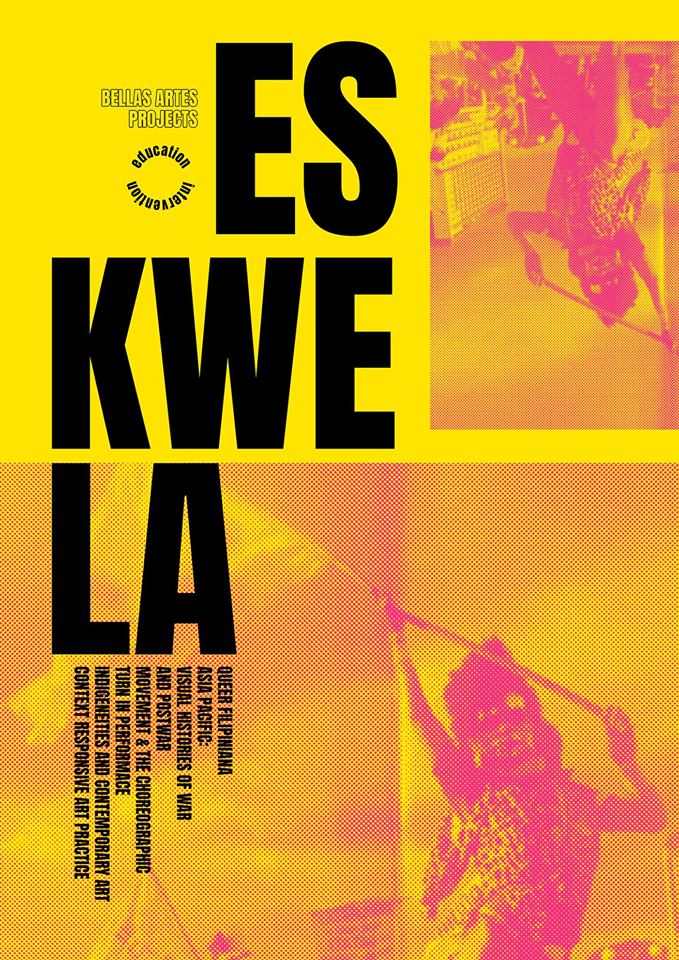
“Our main goal is to create more artistic spaces and widen the reach and role of art in the society,” Guerrero told Nolisoli.ph. “It will give more people the opportunity to practice their passion and learn the topics they never got to.”
Starting this May, the organization will be offering “intensive seminars and workshops” led by respected artists, historians, film theorists, performers, curators, and even anthropologists. The workshops are focused on five subjects deemed as important in the arts and humanities field today. Here’s a short run-through for each:
Queer Filipiniana
This subject is rooted in the fact that in the country, “Filipiniana is often represented in hetero-normative lens,” Guerrero said. They decided to give a critical look into the representation of the Filipiniana at present and in history with an approach not limited to gender. Multi-awarded filmmaker and historian Nick Deocampo, creative writing teacher and writer J. Neil Garcia, and American scholar and transactivist Susan Stryker will be among the instructors.
Asia Pacific: Visual Histories of War and Postwar
Guerrero said they also felt the need to highlight other narratives in World War II, especially the “transformative art practices that followed the aftershock of the Pacific Ocean Theater” where a series of battles took place. The subject will be led by mostly international artists “to give Filipinos a look into the different artistic attitudes across Asia.” The list of lecturers includes Asian American filmmaker James T. Hong whose works mostly highlight historical conflicts and race issues.
Indigeneities and Contemporary Art
How does contemporary art affect the indigenous traditions of each country in the world? Like any other artistic movement, contemporary art has been finding tis way throughout the globe. Curators from Romania, Germany, Canada, and the Philippines will be addressing its effect to the traditions in rural areas.
(READ: Why it’s important to view art to understand than to critique)
Context Responsive Art Practice
Contemporary artists Isabel and Alfredo Aquilizan will be joining Colombian, Turkish, Mexicans, and other international creatives in theoretical and practical workshops that focus on the history and influence of architectural sites to communities.
Movement & Choreographic Turn in Performance
Aside from visual and architectural arts, the program will also be giving performance art mavens a treat with this subject which will have dancer Joshua Serafin at the helm. He will be sharing the “conceptual possibilities of dance and choreography” and its role to the body and in the society.
Students, artists, historians, dancers, museum workers, creatives, or anyone who just wants to study the arts can enroll in all of these classes. If you want to obtain a certificate of participation, however, you should enroll in at least three of these. Each seminar costs P800.
“Eskwela” will have two legs in 2019. The first cycle, which is now accepting applications, will run from May to June while the second cycle is from September to November. Read this catalog to learn more about the first cycle’s schedule of workshops.
Get more stories like this by subscribing to our weekly newsletter here.
Read more:
Artist Leeroy New’s “Aliens of Manila” takes over New York City
LOOK: Local artists pay homage to Apo Whang-Od’s culture through murals
Art Fair has a tea salon where you can try local tea, cocktails, and Thai desserts
Read more by Amierielle Anne Bulan:
National Museum now displays Jose P. Alcantara’s 50-feet relief sculpture
How Francisca Reyes-Aquino sought and fought for our country’s folk dances
Spot the National Artist: Where the BenCab and Ocampo works are in this year’s Art Fair
The International Women’s Month is coming to an end, but that doesn’t mean the recognition we’re giving to women who have challenged gender norms and fought against stereotypes is ending.
While most women strive to raise awareness on the sexist traditions and stereotypes imposed on our gender, a number of people of authority still give more platform for misogyny to propagate. For example: in 2016, comic strip and book writer Frank Cho posted online a “gift” Italian cartoonist Milo Manara gave him during an “Art and Women” panel discussion last February. The “gift” contained an overly sexualized super heroine dressed in a red suit too tight and positioned in a seductive and somehow anatomically impossible pose.
The fact that this gesture was done during a panel discussion that was supposed to address the plight of women in comics is both ironic and disgusting. But what else should we have expected, though? Cho and Manara are two unrepentant comic book illustrators notorious for making women look unrealistic and provocative. And not to mention their notions are backed by the approval of big time comic companies.
The people behind The Mary Sue project, a feminist community who aims to “celebrate diversity and women’s representation” in fields like comic books, movies, video games, among many others, stressed that the roots of sexualized female character depictions can be traced to the “lopsided” comics environment where the favor is towards “privileged cis straight men” who thinks that they’re just “drawing what they like” and aren’t inherently disrespecting women.
‘Women can’t write comics’
And the sexism doesn’t just stop with misrepresentation. It also goes inside, trickling down to comic book creators who are women.
According to New York Times best-selling author and comic book writer Marjorie Liu, when she was starting out in the field, she would hear “crazy shit from editors and bosses that women cannot write comics.”
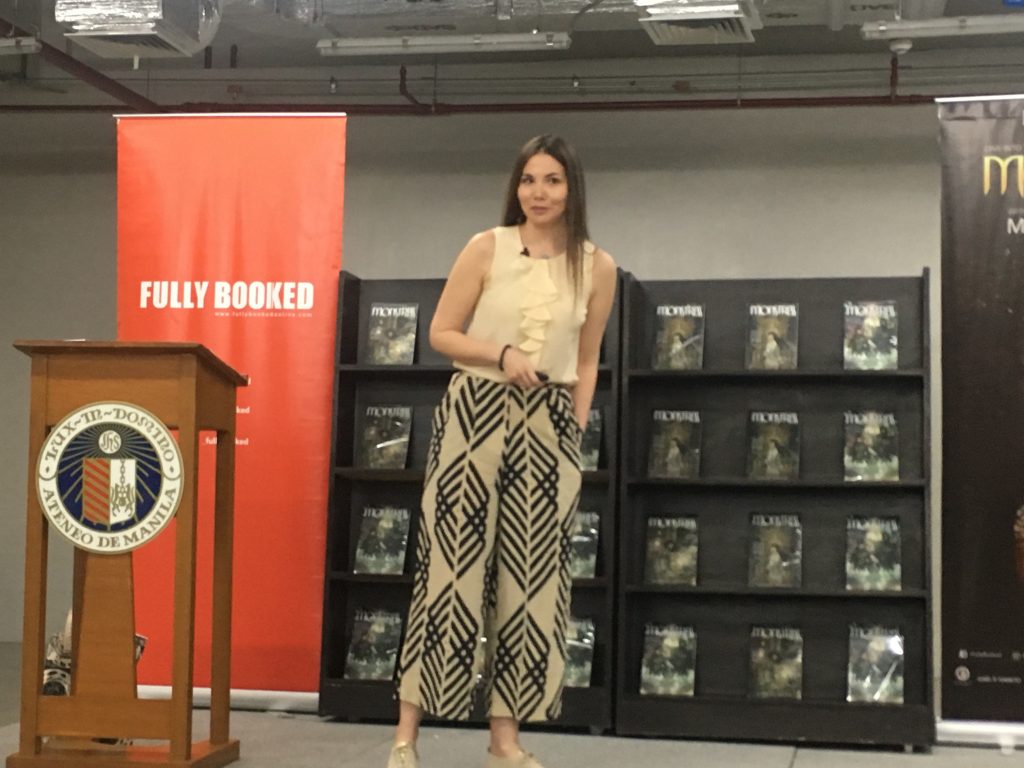
Although big companies like Marvel and DC are starting to make so much noise about diversity (READ: A first look at the design of “Wave,” Marvel’s first Filipina superhero), Liu said some editors still see women in an inferior way. “If they don’t change their ways, the [field] will die. We need actual structural change up top,” she added.”
“While we clamor for this change, we also need more writers and artists exploding into this field, telling their stories relentlessly. There must be new voices, different perspectives, and imagination so that we can get the sort of progressive development our characters and superheroes should have,” stressed the woman behind Monstress, an epic fantasy comics series about an extraordinary female lead.
And people don’t actually have to start big when they want to venture into the field. Local comic book artist Marian Hukom started making indie comics in 2016, back when she was still in college. Her readership has expanded since with her growing number of audience on her Facebook page.
‘Comics are just for entertainment’
Stan Lee himself argued against this myth after standing witness to the “early days when comics are on the very bottom of the cultural totem pole,” he wrote for the George Lucas Educational Foundation. “So many parents and teachers have believed erroneously that if a youngster reads illustrated stories, he or she won’t be able to cope with books that consist only of words.”
It’s not just education they will get but also social reform.
Liu said comics can be a way for creators to speak against injustices in the society such as misogyny, sexism, and other issues.
“I used Monstress to be my platform to raise the fact that women weren’t well represented in the comics industry. There also weren’t enough people of color represented,” she said. “I wanted to speak against colonialism, slavery, and genocide and I did, through the experience of my characters.”
Hukom shares the same notion. Through her indie comics series titled Nagmamahal, Maria Clara, Hukom is able to bridge the contrasting liberal and conservative beliefs of women in this patriarchal society. Based on the Noli Me Tangere character Maria Clara de los Santos, Hukom’s comics “transports” the emblem of a traditional Filipino woman to modern-day Manila.
https://www.facebook.com/NagmamahalMariaClara/photos/a.1911925139021927/2202401213307650/?type=3&theater
“The story focuses on her discovering she’s a model for Filipinos, challenging her own beliefs, and realizing the purpose of her appearance. All the while gaining new friends along the way,” she said.
“The main focus of Nagmamahal, Maria Clara was originally challenging the tradition that’s passed on to Filipino women. But now it’s also branching out on current issues (harassment, etc.) and Filipino values. There’s so much more to cover in future issues!”
https://www.facebook.com/NagmamahalMariaClara/photos/a.1911925139021927/1977075232506917/?type=3&theater
Comic book creators in both the international and local scene like Liu and Hukom are the artists who can pave the way for the unnecessary opinions of men like Cho and Manara to fall into the pitfalls of neglect. We don’t need more men propagating the idea that it’s okay to objectify women, even if it’s just (God forbid their lame excuse) “for artistic purposes.”
Like what Liu and Hukom are doing, everyone can depict women in a respectable matter just by being a decent human being. Women deserve this, not just this International Women’s Month but beyond.
Get more stories like this by subscribing to our weekly newsletter here.
Read more:
Artist Leeroy New’s “Aliens of Manila” takes over New York City
LOOK: Local artists pay homage to Apo Whang-Od’s culture through murals
Spot the National Artist: Where the BenCab and Ocampo works are in this year’s Art Fair
Read more by Amierielle Anne Bulan:
National Museum now displays Jose P. Alcantara’s 50-feet relief sculpture
How Francisca Reyes-Aquino sought and fought for our country’s folk dances
Why it’s important to view art to understand than to critique
When Art Fair Philippines opened seven years ago, the founders’ goal was to dedicate the platform to modern Filipino art works. “It was a new exposition focused exclusively on Philippine contemporary art,” a 2013 Inquirer article wrote.
The fair grew with this objective, standing witness to the works of many artists that incorporate new trends and ideas such as sculptor Louie Cordero’s out-of-shape ping-pong table in 2014, Dex Fernandez’s video installation of his hand-drawn animation in 2017, and the currently on display “Finding the Light” by Daniel de la Cruz, which shows sculptures illuminated by smartphones attached to it.
But with the fair being a sea of new and modern artworks, we wondered if there are some works by veteran and National Artists for Visual Arts on display. One gallery assistant said no, “the Art Fair is mostly filled with pieces by contemporary artists. You won’t find much works of National Artists here.”
While hopping from gallery to gallery, however, we were able to spot familiar strokes by some of our National Artists for Visual Arts (including a J. Elizalde Navarro sketch). So if you’re also wondering where to find our National Artists’ time-honored pieces at the country’s most contemporary art gathering, here they are:
H.R. Ocampo
“Abstraction 148” (1978)
1335Mabini, 7F #53

If you’re familiar with Ocampo’s artworks, you’ll instantly recognize this piece even if you’re meters away. “Abstraction 148,” the only solo Ocampo displayed in the fair, boasts of every element the artist injects in his works: smoothly assembled biomorphic shapes, complementary bold colors, and a finish that exemplifies movement and nature. A pioneer of modernist art in the Philippines, Ocampo was fond of depicting the country’s rich flora and fauna in his abstract works—which in this case can be seen by his use of warm, earth-like tones.
J. Elizalde Navarro
“Untitled”
1335Mabini, 7F #53
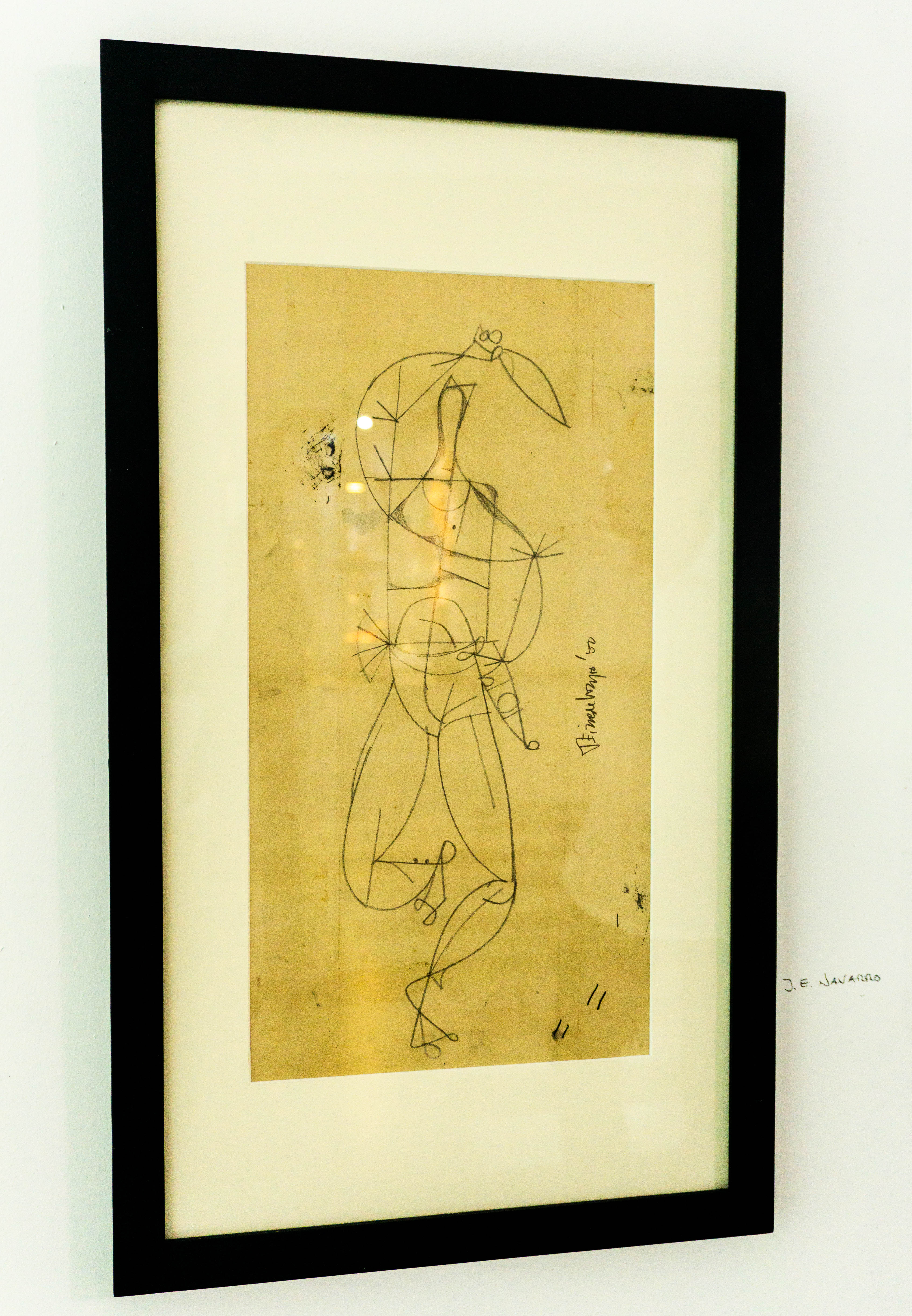
This untitled sketch is possibly a study of one of his figurative paintings, but we’ll never know for sure since Navarro’s style has always been unpredictable. “It may be one of the sketches he just came up with in one sitting,” the gallery assistant told Nolisoli.ph. Navarro is known for his versatility, being knowledgeable in fields like painting, printmaking, drawing, graphic designing, and even sculpting.
Ang Kiukok
“Door” (2000)
Léon Gallery, 6F #24

Is it three doors or four? We’re not sure. But we do notice that Ang’s inclination to cubism and expressionism is visible in this illusion-like piece that depicts an array of open doors. The strongly colored subjects of Ang’s oil-on-canvas are made up of the prominent lines and geometric figures that immediately draws in the viewers’ eyes.
Benedicto Cabrera
“BenCab x Mariwasa Tiles”
Tin-Aw Gallery, 6F #25
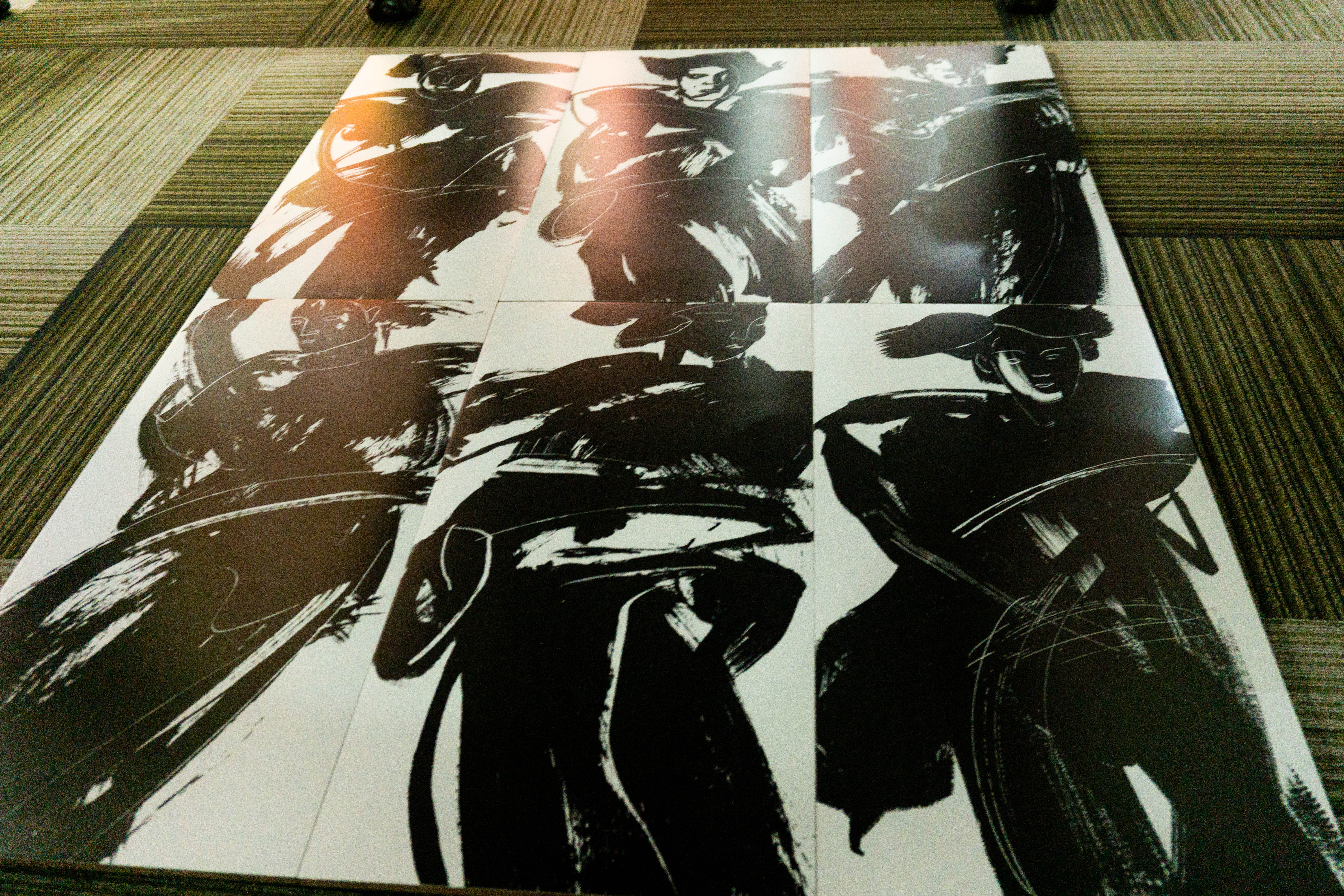
It’s a BenCab you won’t immediately notice since it’s fittingly situated under multimedia artist Cian Dayrit’s table that’s topped with stone sculptures arranged in a way that resembles the Philippine map. The six-piece artwork shows a figure clad in something moving with the rhythmic brush strokes embracing it—an element we often see in the artist’s works.
“8 Muses”
Secret Fresh, 7F #50
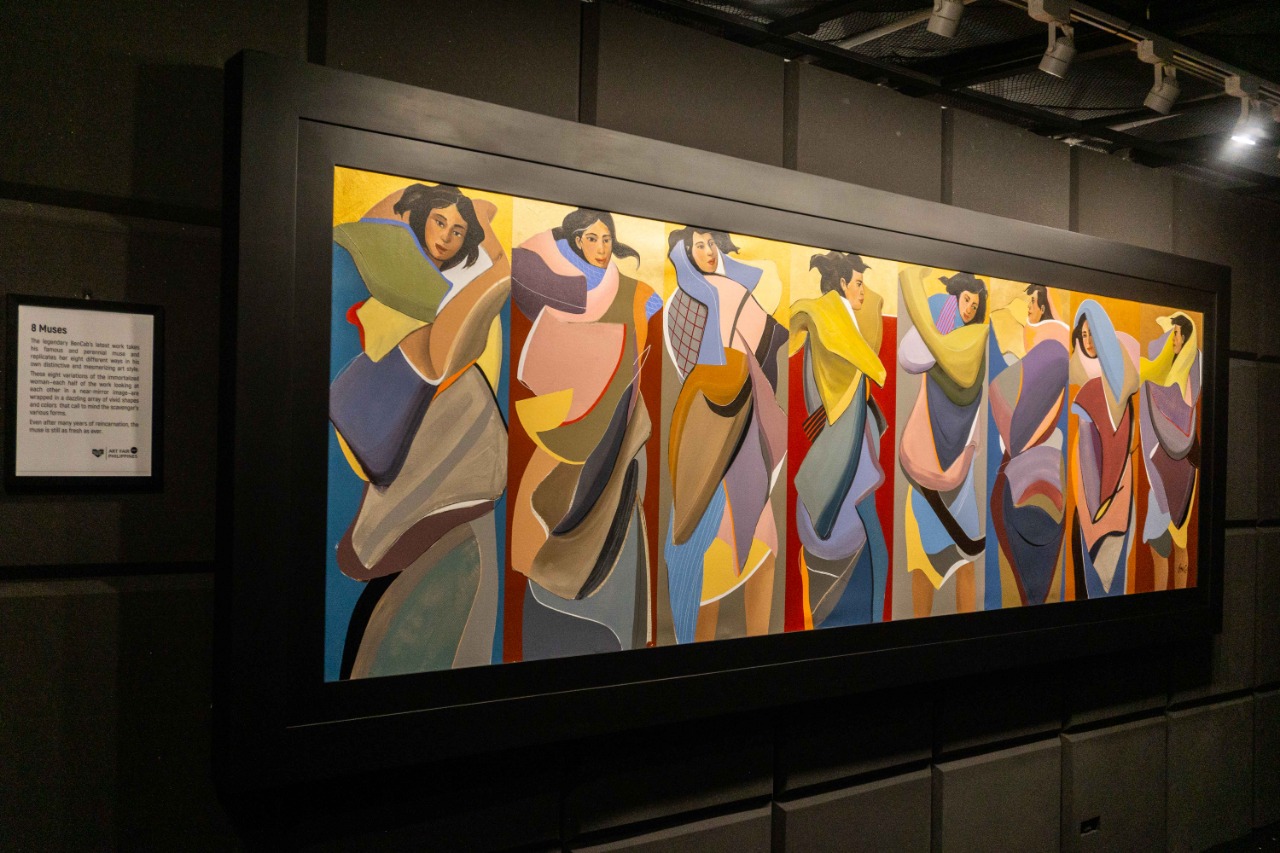
BenCab has another treasured tucked also somewhere unconventional in the art fair. While the earlier piece is under a table, this one’s behind a black curtain. And like the above-mentioned piece, “8 Muses” is also a part of a series the artist is truly known for: his perennial muse from Bambang, Sabel.
Arturo Luz
Graffiti
The Crucible Gallery, 7F #38
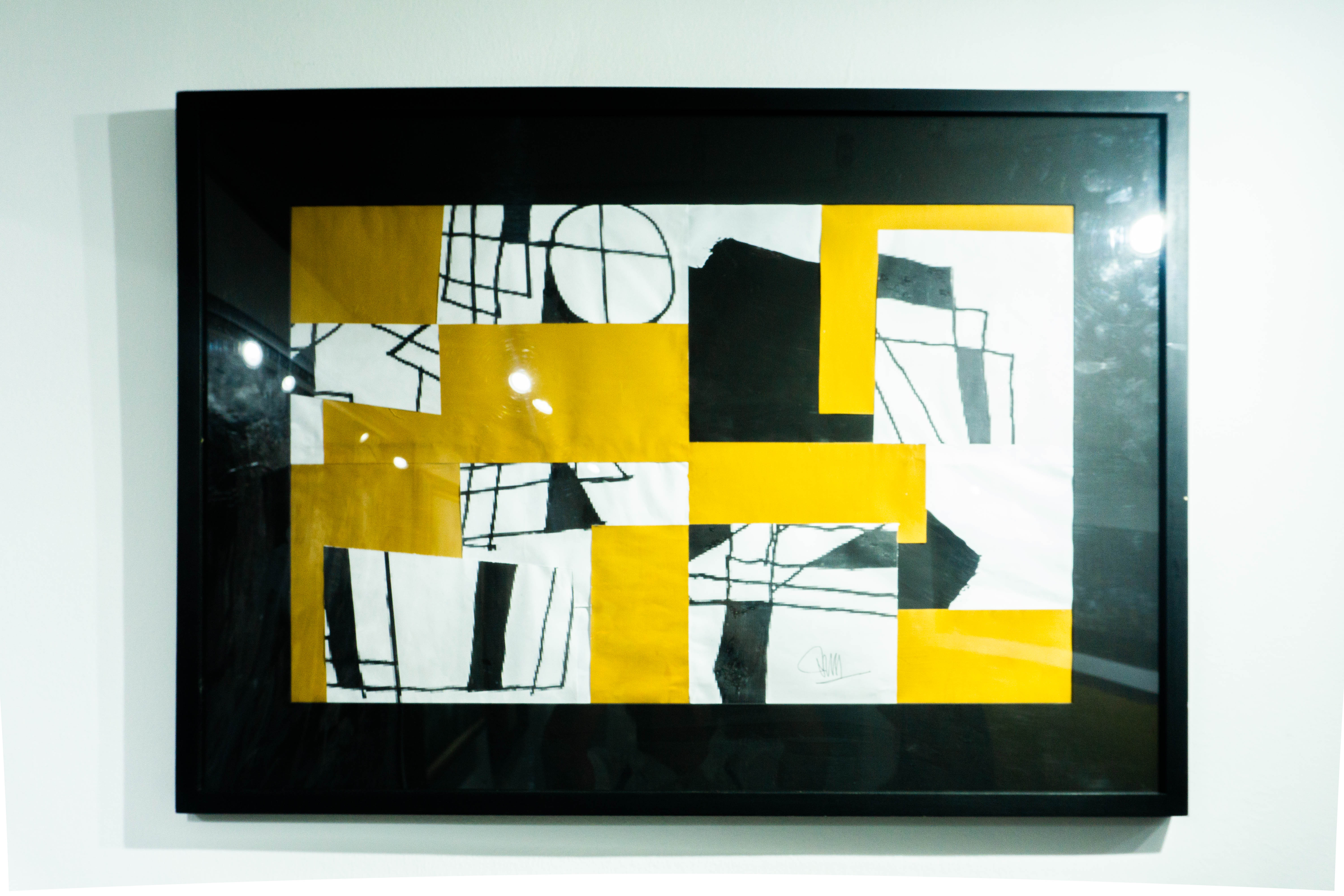
Luz’s style of abstraction has always been both simple and complex. His use of linear and minimal shapes and patterns may seem like the art is what it is: two-dimensional and simplified. Yet the longer you look, the more figures you see and the more elaborate it becomes. It’s one of the greatest things about Luz’s use of geometry.
“Homage to Isamu Noguchi” and “Tribal”
The Crucible Gallery, 7F #38
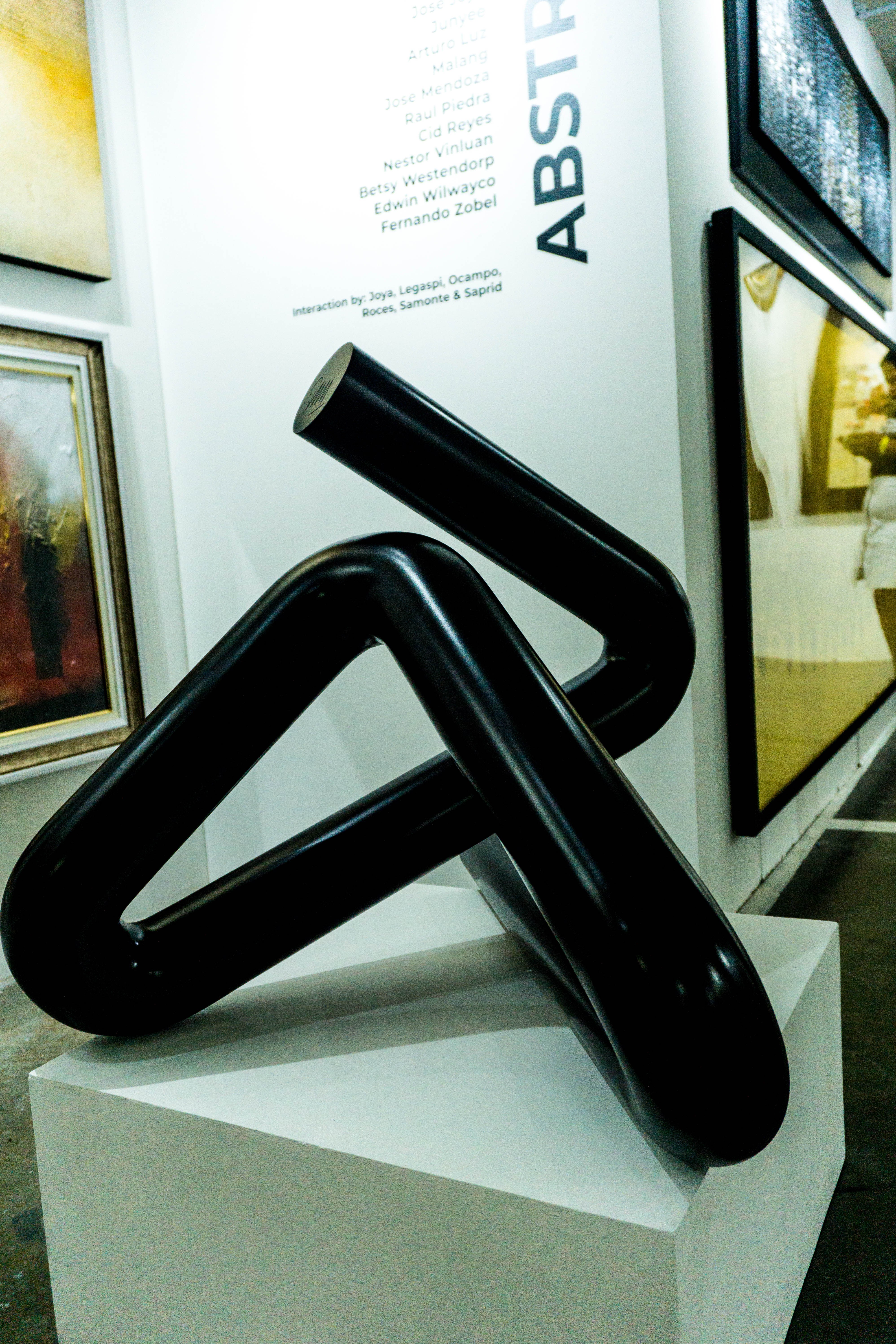
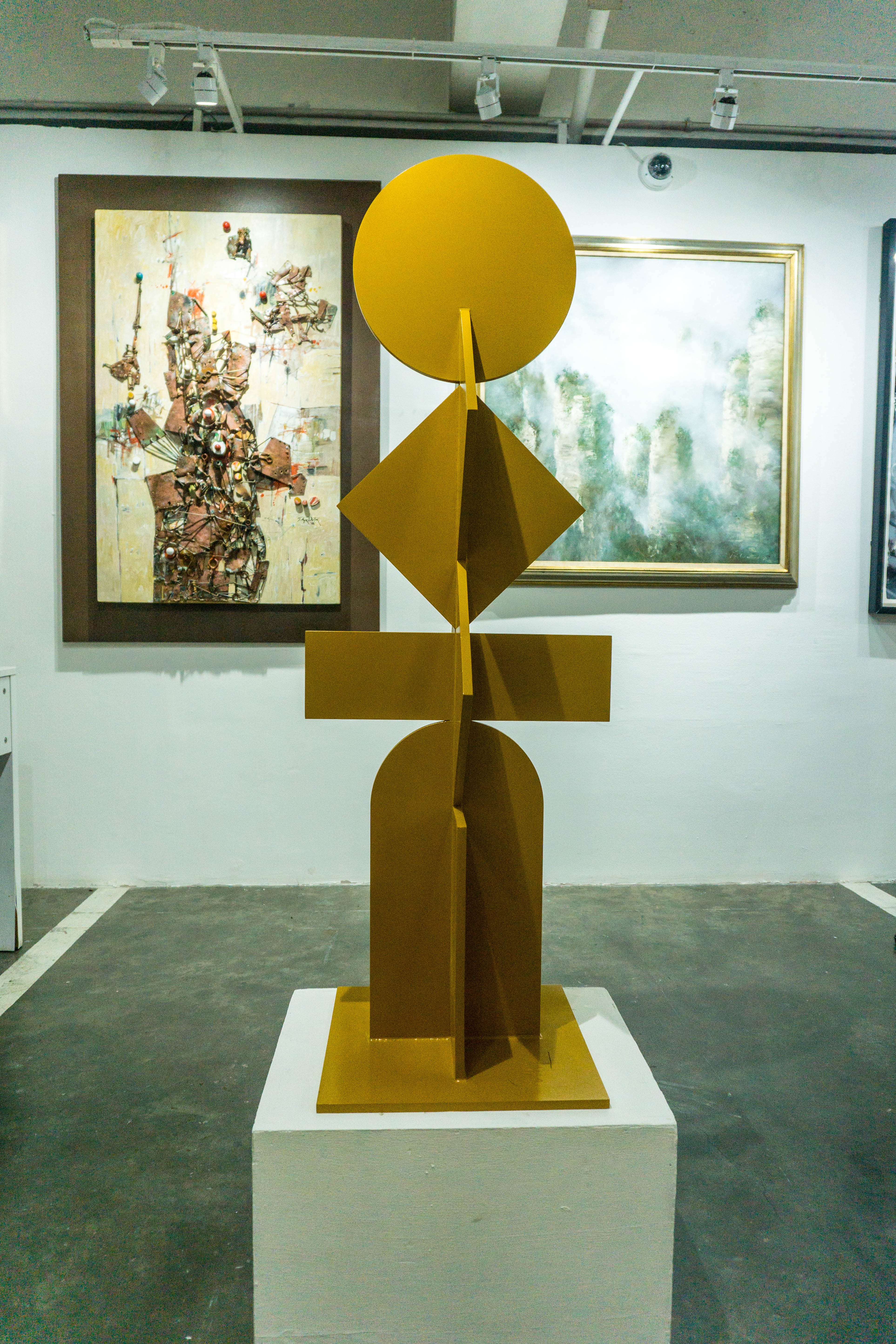
Also on display are Luz’s popular works depicting a deconstructed paperclip inspired by Japanese artist Isamu Noguchi’s raw sculptures and a monochromatic stack of geometric shapes.
Jose Joya
“Desert Blossoms” (1991)
The Crucible Gallery, 7F #38
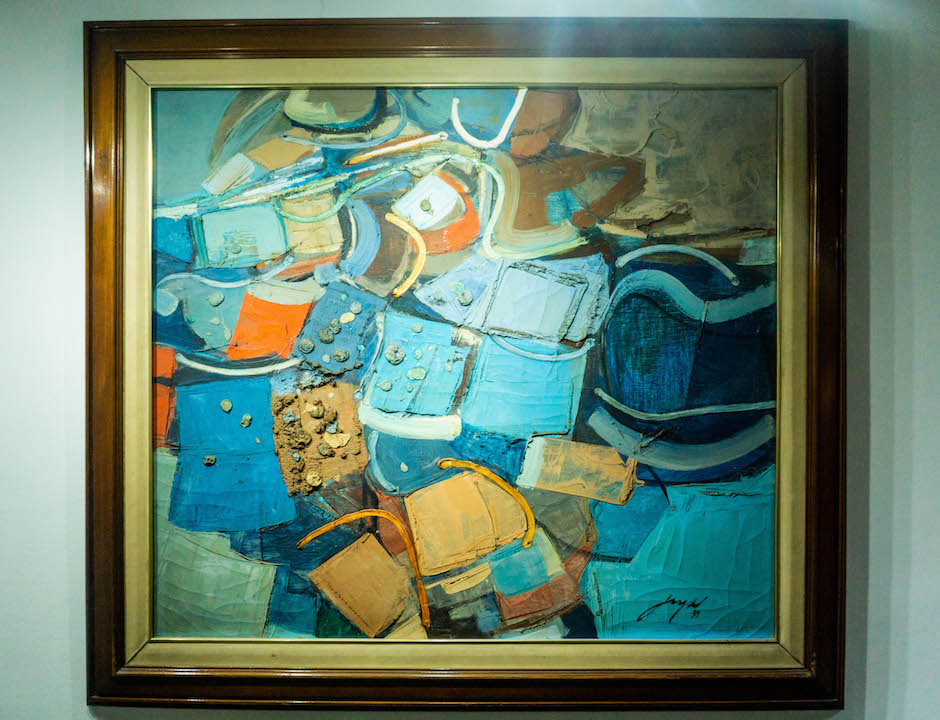
Also known as one of the most valuable pieces in the fair (READ: Hidalgo, Joya, and Zobel: The most valuable pieces at Art Fair 2019), this oil-on-wood painting boasts of a true Joya: dipped in abstract expressionism, accented with heavy impastos, and has tropical colors with dominant blue hues.
Jose Joya, Cesar Legaspi, H.R. Ocampo, Alfredo Roces, Rodolfo Samonte, and Solomon Saprid
“Interaction”
The Crucible Gallery, 7F #38
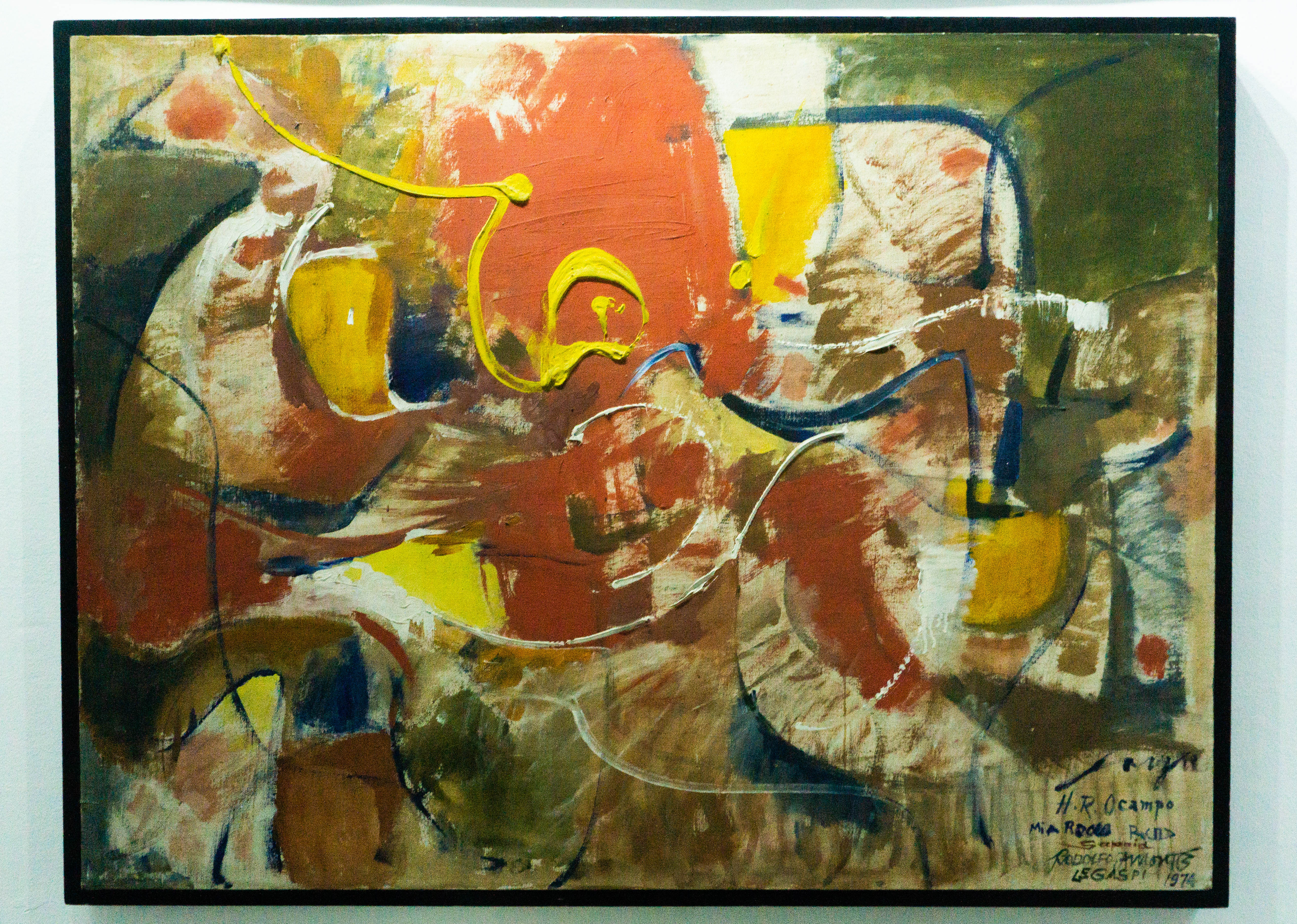
An abstract piece already has a lot of stories to tell; but this one is backed by the historical collaboration of six important Filipino painters. Displayed below the Joya painting is a historical canvas touched by the brushes of national artists Joya, Cesar Legaspi, and Ocampo and veteran painters and friends Alfredo Roces, Rodolfo Samonte, and Solomon Saprid who collaborated 45 years ago and made this interaction painting.
Art Fair Philippines 2019 runs from Feb. 22 to Feb. 24 at The Link Carpark.
Read more about Art Fair:
The Nolisoli.ph Guide to Art Fair Philippines 2019
Malang, Fernando Botero, David Medalla, and other artists featured for Art Fair 2019
All the art events happening this week outside of Art Fair Philippines
The Ultimate Art Fair City Guide
In every February for the past years, Rizal Park had stood witness to the National Commission of Culture and the Art’s (NCCA) launching of the National Arts Month. While it had become some sort of an understandable tradition—Rizal Park is, after all, the heart of the country’s capital (it’s literally kilometer zero)—it had been challenging for cultural agencies to actually make the celebration national and not just Manila-based.
This is why this year, NCCA tapped the local government of Bago City in Negros Occidental to host the opening of this year’s National Arts Month on Feb. 1. “Instead of doing the usual launching we do in Luneta, we have partnered with Bago City, which is just 30 minutes outside Bacolod City,” said NCCA deputy executive director Marichu Tellano in a press conference earlier this week.
“What we usually do in Luneta [for the Arts Month] will be transposed there so our people in Negros will have the experience of the creative processes of what we show here in Manila,” she added.
Aside from the kick-off, NCCA’s partnership with Bago City also paved way for the launch of the Colegio San Agustin-Bacolod’s new scholarship program called “Hanas” for budding artists in the region.
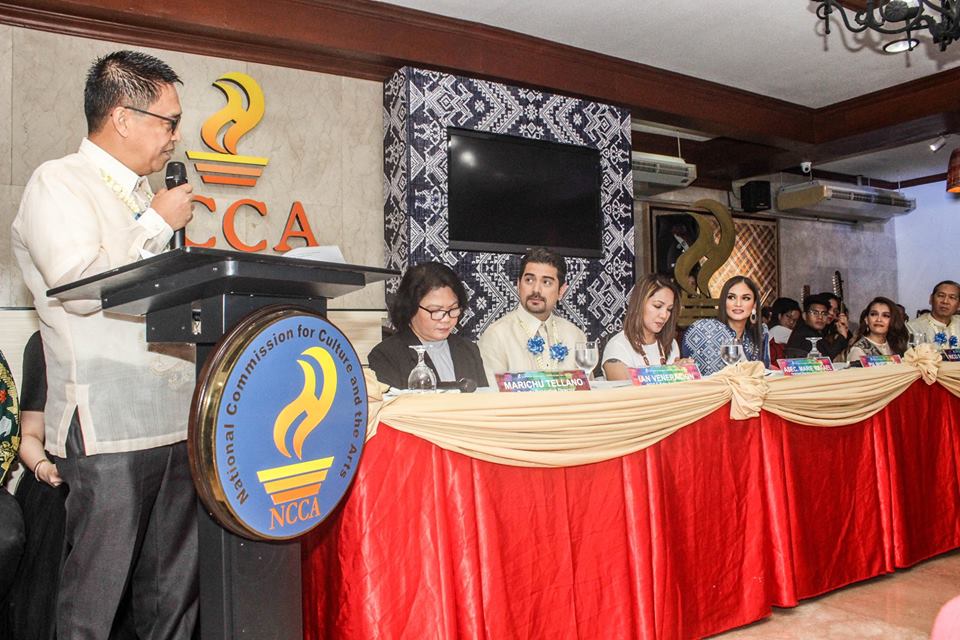
Bago City will lead the opening celebration while other regions in the country will follow through. Two celebrations will be held in Luzon: one in Lucky Chinatown Mall in Binondo, Manila on Feb. 3 and the other in Bagac, the largest municipality in Bataan, on Feb. 8.
For Mindanao, Koronadal City in South Cotabato will hold the ceremonies on Feb. 15.
“We try to ensure that all the other activities of the other committees, the theater visual arts, music, literary arts, would be spread in the different parts of the country,” Tellano said. “The whole rationale is this celebration is national. Let our people experience the sense of creativity that is led by the NCCA.”
Titled “Ani ng Sining: Philippine Arts Festival,” this year’s National Arts Month will be composed of programs under the seven national committees under NCCA: Architecture, Cinema, Dance, Dramatic Arts, Literary Arts, Music, and Visual Arts.
For Architecture, committee head Rogelio Caringal will host a traveling exhibit and forum from Feb. 22 to Mar. 21. The program, called “Loob at Labas: Talakayan at Pagpaparangya,” focuses on “enhancing appreciation and awareness on Philippine architecture.”
The 11th installment of the non-competition film festival Cinema Rehiyon will mark this year’s Arts Month celebration in the field of Cinema. NCCA head commissioner Teddy Co himself leads the program, which will highlight films from different regions all over the country. The festival will run from Feb. 23 to Mar. 1 at Foundation University in Dumaguete City, Negros Oriental.
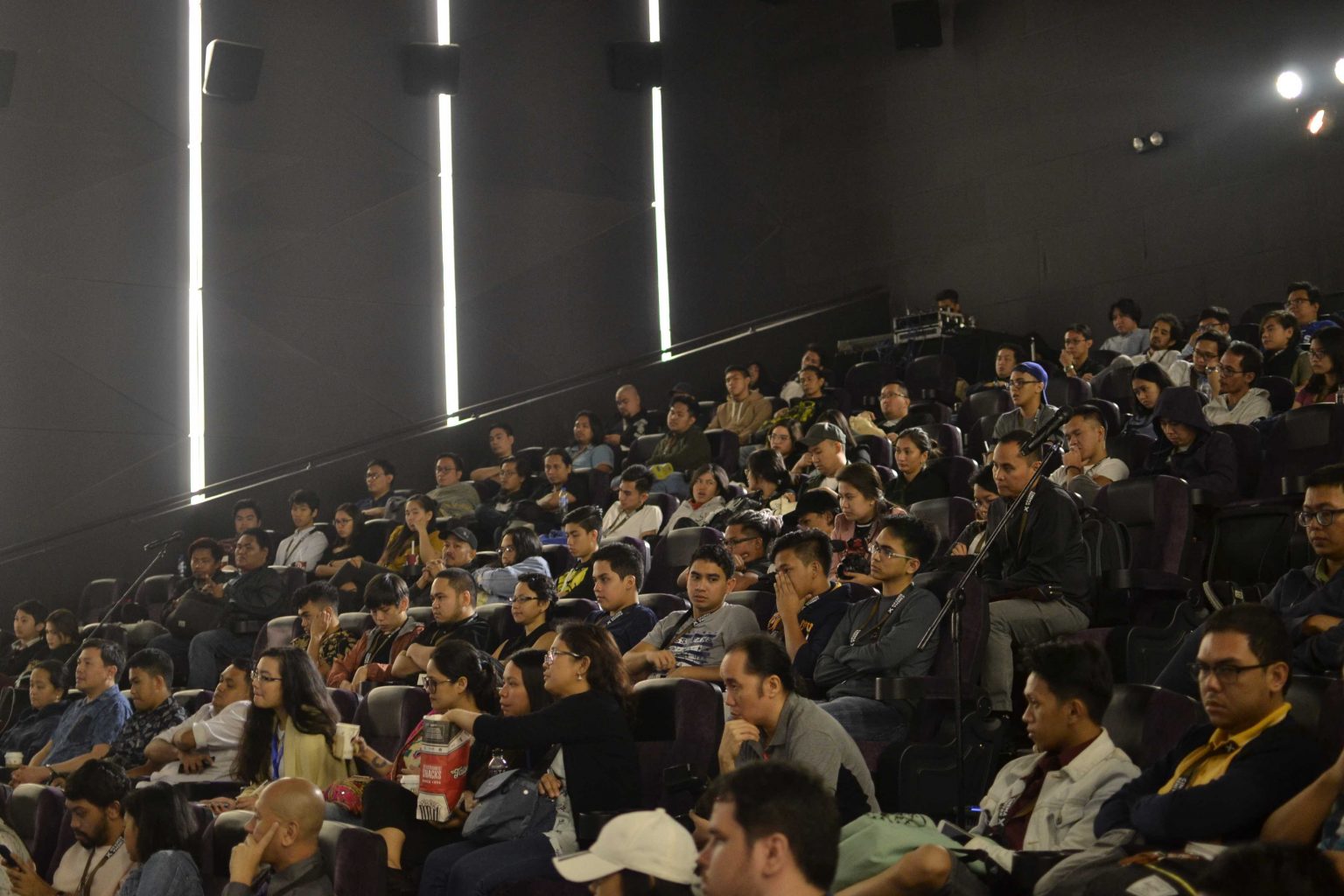
Well-known dancer Shirley Halili-Cruz, committee chairman for Dance, will once again lead “Sayaw Pinoy,” the country’ longest-running dance traveling concert series which features various dances. This year’s tour will include classical ballet, folk dance, contemporary, and modern dance.
Traveling concerts, lectures, and workshops will also be offered by the Music committee headed by Mauricia Borromeo. Their music festival “Musicapuluan: Music of the Philippine Islands” will be held in Catbalogan City, Samar on Feb. 1 and 8, Baguio City on Feb. 8, and Dumaguete City, Negros Oriental, on Feb. 23.
A series of performances, workshops, and discussions converged in the project called “Tampok” will be the dramatic arts’s main program. Led by Rossana Palm, head of the Dramatic Arts committee, Tampok will start on Feb. 26 to March 1 in the University of the Philippines Los Baños, Laguna, Feb. 27 to March 1 in Malabon, Feb. 28 to March 2 in Bohol and March 2 to 4 in Ozamiz City, Misamis Occidental. Another converged project called “NAMnamin,” which combines food and literature, will be the Literary Arts’ project from Feb. 25 to 27 at The Orchid Gardens, San Fernando, Pampanga.
An arts festival composed of art talks, workshops, and exhibits by local artists will be held by the Visual Arts committee from February 4 to 7.
May we continue to engage with and empower more Filipino artists, both budding and veteran, through events inside and outside Metro Manila.
Header image courtesy of Faith Yangyang / NCCA Public Affairs and Information Section
Get more stories like this by subscribing to our weekly newsletter here.
Read more:
LOOK: Kalinga tattoo artist Apo Whang-od to receive NCCA award
These five NCCA-awarded structures are a short trip away
Congress has just voted to save our indigenous games
Read more by Amierielle Anne Bulan:
Artist made labyrinthine paintings look light and calming in new exhibit
Nikki Luna’s latest exhibit sheds light on the struggles of women in an anti-woman society
A yoga retreat might be your best remedy for burnout
The artistry of fashion designer Cesar Gaupo was as limitless as his mind. One would know just by observing his sophisticated designs of ready-to-wear clothes, gowns, and footwear. His creative skill had even transcended to other fields of design, as witnessed by his friends and colleagues who have visited the forest-tucked house sketched, designed, and built by Gaupo in Majayjay, Laguna.
“It’s the most beautiful tropical house I’ve ever seen,” recalls fashion designer James Reyes who went to Gaupo’s Balinese-styled mountain resort in the summer of 2011. Reyes even remembers vividly the first time he glanced at the home. “When we arrived, we were greeted by Cesar peeking out of the huge front gate. Then he stepped out, naka-pamewang. ‘At bakit ngayon lang kayo?!’ Sabay malakas na tawa!”
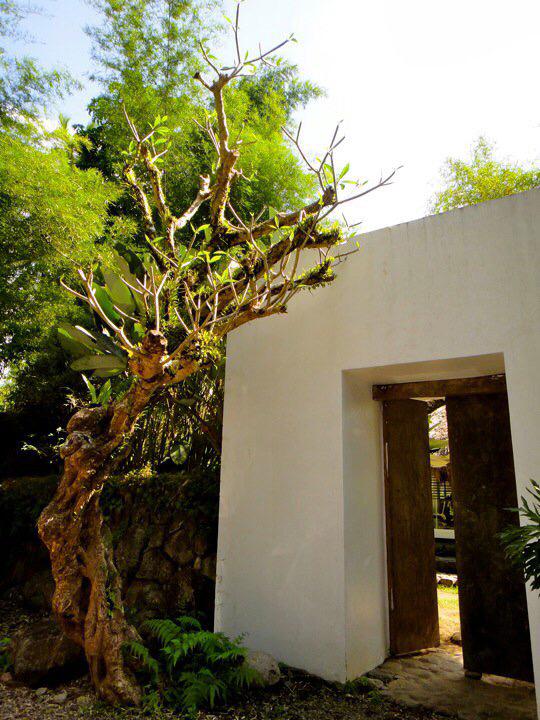
The front gate Reyes was referring to was a tall white-washed concrete wall that surprisingly blends naturally with the area’s green foliage. In the middle of the wall are antique wooden doors. Push these open and, as Reyes recalls, you will be greeted by an open layout, a vast lawn that separates two structures: the living room and receiving area at the left and the dining area at the right. Both designed like a nipa hut.


“Both structures feature very high and very imposing thatched roofs,” says Reyes. The high ceiling, where an intricate layer of cogon serves as roofing, provides ventilation, making the use of air condition or electric fans unneccessary.
A grassy courtyard and large stone steps lead to the living room. Once you’re inside, you’ll notice two sets of big wooden doors on opposite sides, giving way for the forest’s airiness and relaxing ambience to pervade the structure. A juxtaposition of concrete and wooden furniture fill the room’s marble flooring, accented by Gaupo’s trinkets, bold-colored pillows, lamps, and reading materials.
One wouldn’t notice much difference once the doors are closed, however, since no concrete walls separate the inside from the outside. Only glass corners paired with wooden blinds keep the living room enclosed.

The same set of thatched cogon roofing tops the pavilion enclosing the six-seater dining area. Unlike the living room, this structure carries a more simple layout. Raj-styled wooden chairs and a round antique table are in the middle while a wooden buffet table and tea trolley stand quietly at the back.
In between the two structures is another gate, as if Gaupo’s unconventionally built nipa hut-styled receiving rooms aren’t enough to leave guests in awe. The doorway leads to stone steps wet by the running river it is located on. These steps, designed and built by Igorot workers, lead to another white-washed concrete wall that apparently separates Gaupo’s master bedroom from the whole property.
This means before you reach the bedroom, you have to climb the stone steps wet by the cascading river surrounded by green foliage. “You will definitely get your feet wet when you cross the brook,” says Reyes.

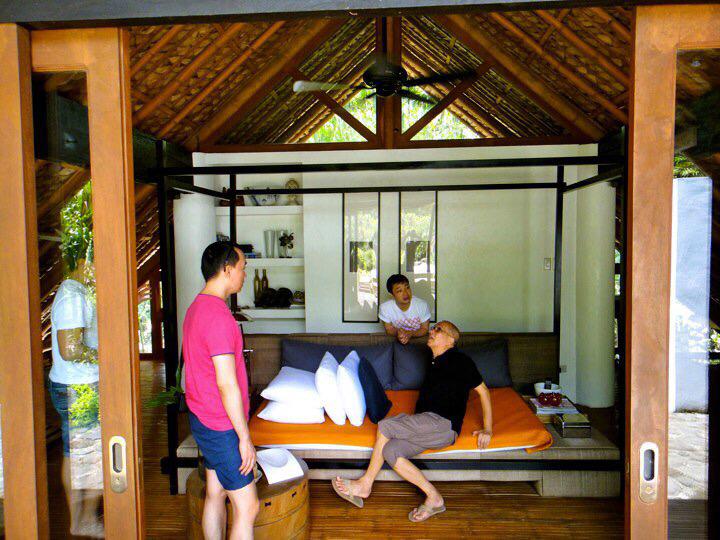
From floor to ceiling, Gaupo’s master bedroom is dominated by bamboo. At the middle is a four-poster bed that Gaupo also designed. Behind the headboard is a tall white wall and hiding behind it are the toilet and bath. But the one detail that still fascinates Reyes up to this day is the one hidden under Gaupo’s bedroom floor.
“Cesar had vents installed at the floors of his bedroom,” he says. “Since this structure is on stilts, therefore elevated, the naturally cooled breeze from the running river enters his room constantly, so he doesn’t need air-conditioning at all. His bedroom is always cool. In fact, Cesar said it gets really cold in the morning.”

Another interesting part of Gaupo’s bedroom is the courtyard in front of it where a white-washed concrete wall with a picture window stands. “No function really, just for additional privacy, but it creates an interesting frame against the lush forest.”
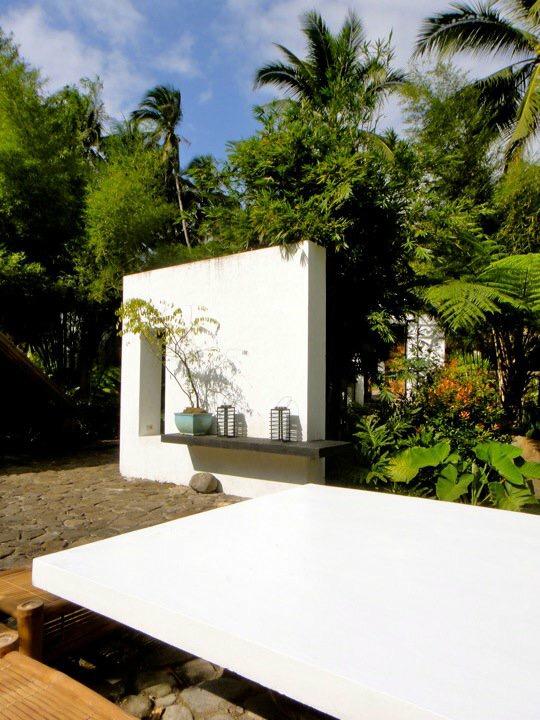
Reyes only visited Gaupo’s home once, but its impression on him lasted for years.
“It’s a well-designed juxtaposition of rigidness and nature,” Reyes tells Nolisoli.ph. And come to think of it, the whole compound is actually a mix of those contrasting things—from the living and dining room’s marble flooring and thatched cogon roofing to the doorways’ imposing entrances built on stone steps by the river. It’s a mixture of all things modern and antique, carefully sewn together by the artistry of Gaupo.
As Reyes said, “Only a brilliant mind can think up of these details.”
His passing last Saturday was truly a sad moment for the Philippine design world. But like what his friends and peers said, Gaupo will always be greatly remembered not just for his works, his mentorship, his house, but also for his happy and humble self. (Read: Friends and peers recall the happy and humble “bagets” that was Cesar Gaupo).
All featured photos courtesy of Boboy Consunji
Get more stories like this by subscribing to our weekly newsletter here.
Read more:
Celebrated designer Cesar Gaupo passes away
Richest man in PH, Henry Sy Sr. passes away at 94
Fashion is political, according to the young designers of Toqa
Read more by Amierielle Anne Bulan:
Artist made labyrinthine paintings look light and calming in new exhibit
What most Filipinos should know about Sinulog, according to Cebuanos
CCP is turning 50 this year. Here are events to look forward to









